With a there's more where that came from attitude, I have decided to introduce my other coins and bills I've got floating around from various places around the world, and through the ages. And there are quite a few indeed! Many years ago I would put them away, disregarding their worn-out raggedness, and forget about them. I didn't care about their value as collectibles, it was more just a curiosity for me. Although, in certain cases, like these pretty Czechoslovakian Koruna banknotes, I used them for decorating my walls.
From the Final Years of the Country
These three bills remained with me from a visit to Prague sometime in the early 1990's. They were relatively new, having been issued between 1986 and 1989. Around that time Czechoslovakia was going through some major changes: After the fall of the Iron Curtain, known locally as the Velvet Revolution, the republic changed its name from socialist to federal. However, that new entity didn't last very long, as the entire country dissolved into the separate Czech and Slovak republics soon after, discontinuing its former common currency. In my opinion a pity, at least for the money, as this entire series of banknotes was remarkably pleasing to the eye. This was apparently clear to the good folks from the Czechoslovak central bank too, since the designer of these bills, Albín Brunovský is explicitly mentioned on each one of them.
Colorful Obverse, Picturesque Reverse
Starting out with the 10 Kčs note, we are treated for an explosion of blues and greens in the dominating white-brown theme. Unlike with most currencies, where each denomination has mainly one color, or the USD, where all banknotes have the same color, these koruna bills seem to want to incorporate as many colors as possible! And this is just the beginning, with the face of the poet Pavol Országh Hviezdoslav on the front.
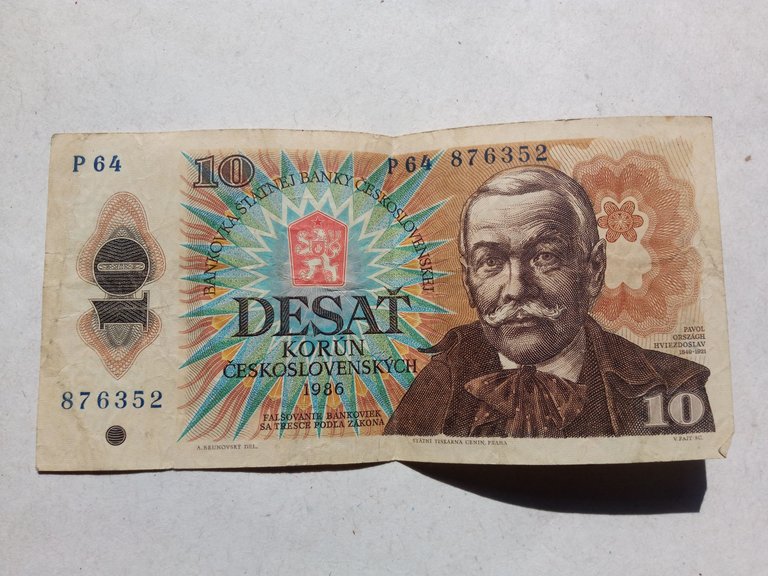
The reverse side of the same banknote features a lovely landscape from Orava / Árva County, a mountainous region in present day Slovakia, which is also where Országh-Hviezdoslav from the obverse side was from. I just love looking at the elaborate image on this small bill (133 × 67 mm). There's so much going on, from the sunburst, to the forested hillside, to the presumably endemic bird species, and the wild strawberries on the right margin.
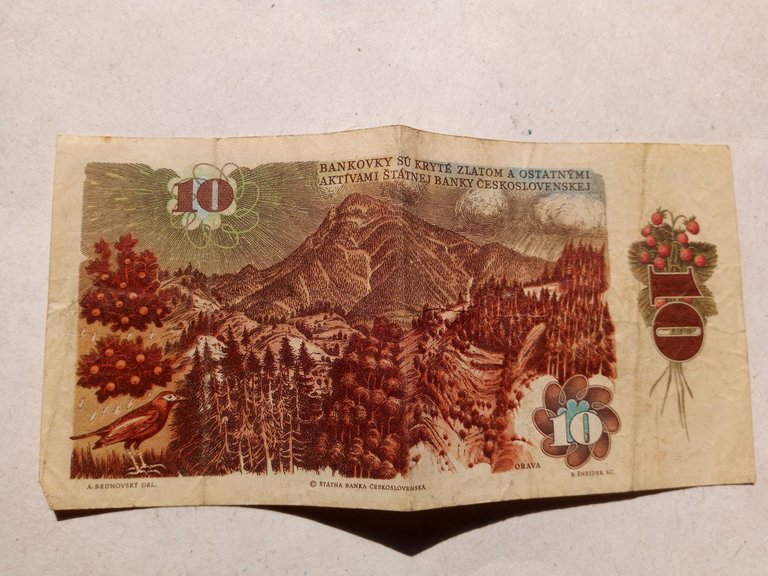
A Poster on My Wall
Continuing with the 20 Kčs bill, the colors and the designs get even better! Granted, this particular banknote shows a good amount of wear (and a bit of tear). It may have been crumpled up in pockets, so the colors have lost some of their brightness. Still, the design is breathtaking, with a flourishing tree, a starry firmament, and a heavy looking book in what could be the sun disk. The featured personage is 17th century philosopher Jan Amos Komenský, considered the father of modern education.
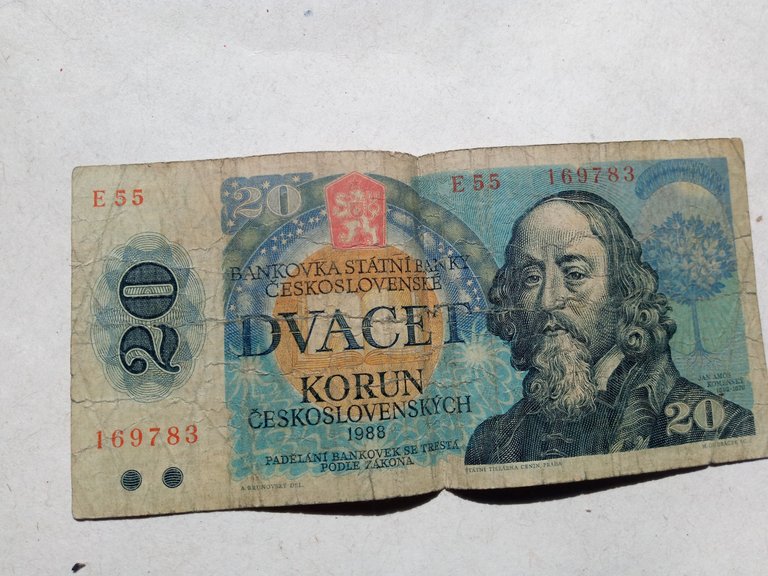
Taking the theme of education to a higher level, the obverse of this bill looks so nice that I also tried to elevate it to something more: I took it to a copy shop, and had them print it out in a DIN A0 size (841 × 1189 mm), which ended up on the wall of our study. Quite appropriately, all the images on it have to do with feeding the mind: the tree of knowledge with its colorful fruits, growing out of a thick book, the ancient texts all around, probably from the Bohemia-Moravia region, the armillary sphere for the tracking of celestial bodies, and even the young couple in their mid-20th century garb, reading a big book together. Though the bill is mainly blue, the reds, yellows, oranges, and greens give it an incredibly pleasant appearance. I don't have the poster any more, but I can say it looked great in the study.
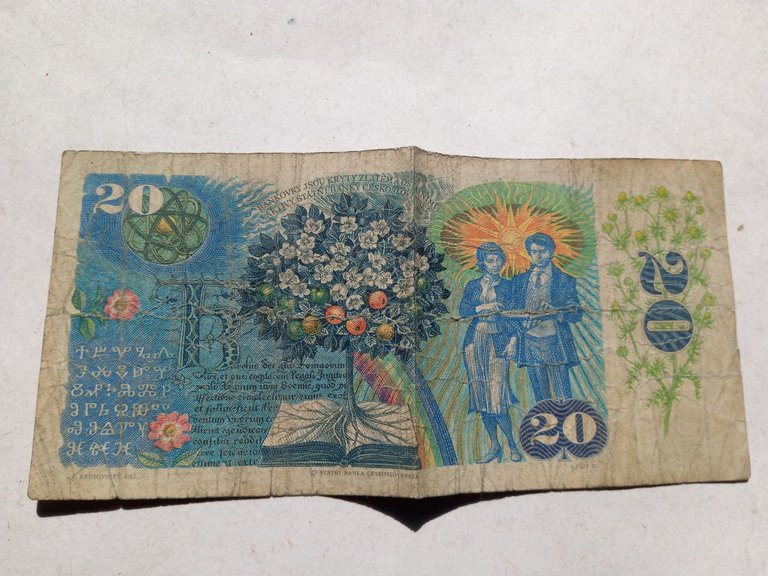
An Inspiring Beard and A Detailed Cityscape
Finally, the 50 Kčs banknote takes on a red colored theme, which however is extended by plenty of other colors, particularly on the back. The front of the bill shows Ľudovít Velislav Štúr, an important Slovak political writer and revolutionary from the 19th century. Without diving too deep into the life of this proponent of the Slovak language and national identity, I would like to mention his impressive beard - if that's what's fluffing out from under his collar. Okay, okay, maybe that IS his collar. Still, while that's the part of facial hair even bearded guys like to shave off, looking at this note makes me want to cultivate the hair growing on my neck...
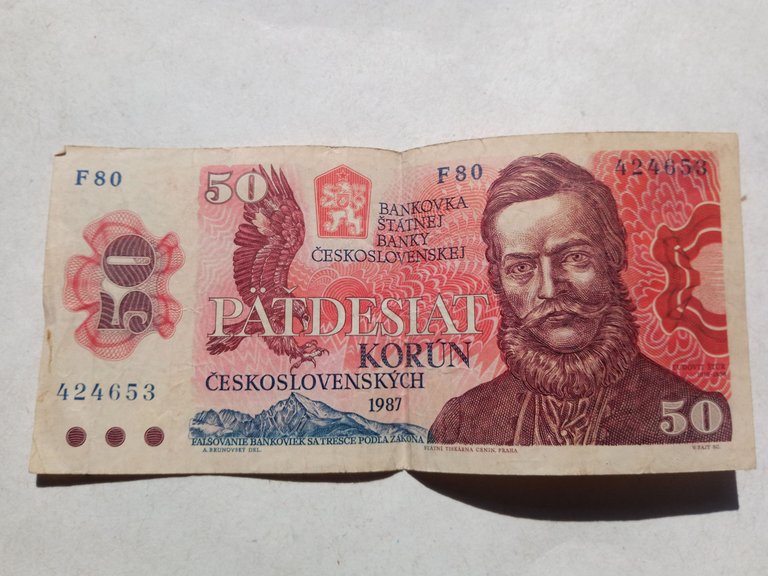
The reverse side of this banknote is also impressive, with its detailed view of Bratislava, including its famous castle and churches. Unashamed of their place in modern history, this bill also includes the more recently built concrete blocks, and its ugly multi-lane highway diamond, connecting the road on the bank of the Danube with the bridge crossing it. Though this image in by far not as interesting as the other two reverse sides, what I like here are the green colored river, and the uneven blue rings in the top left corner, possibly symbolizing the sun. Even though I couldn't see myself making a poster out of this, it's still better looking than many banknotes from other countries.
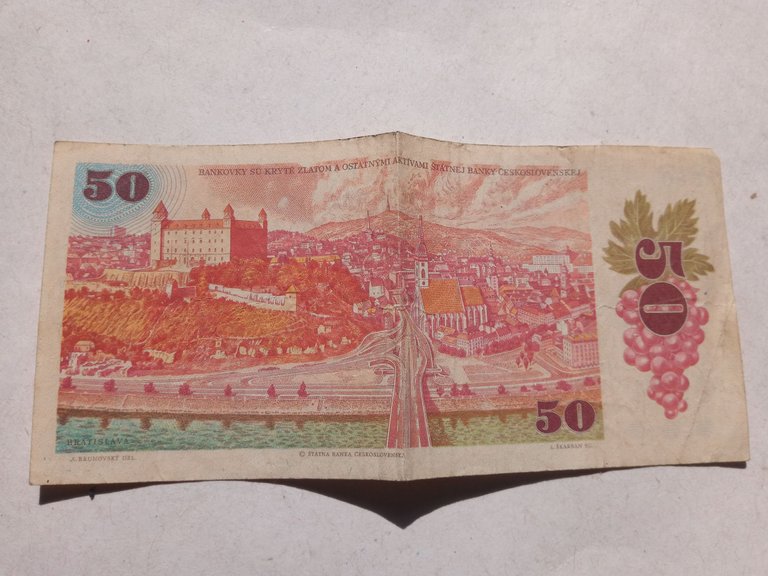
Visit the Previous Post in my Funny Money Series:
Mexico - Looking at Some Old Coins
Yugoslavia - Lots of Zeros Before the War
Nice wall decoration definitely 😉
We have no banknotes under the 100 crowns now. 10, 20 and 50 nominals are only the coins in Czech Republic now.
We use banknotes in 100, 200, 500, 1000, 2000 and 5000 CZK. I have only two of them in my pocket now, but here you can see 🤣
Oh no!!! Are they adding zeros? - That was the theme in my last two posts in this series, and I'm sure I'll keep mentioning it again when I make Funny Money posts in the future.
But those are neat looking bills too! Thanks for sharing. And yes, they are somewhat colorful too. Are the reverse sides as spectacular as the ones designed by Albín Brunovský?
Hahaha, I just HAD to look them up. Wow, I actually quite like the reverse images of today's Koruna bills! My favorite I think are the 200 and the 500 Kčs. Still, I imagine them as huge printouts on my wall! 😉
Yes, it seems like they added zeros, because you own 20 crowns banknote with J. A. Komenský and now we use 200 crowns banknote with the portrait of the same man ;)
But in real, it is not based on hyperinflation. We have still 10, 20, 50 crowns, but only as a coins. On the other side, we have 1000, 2000, 5000 banknotes, which didn't exist before 1993.
Anyway, thanks for sharing your banknotes, because those I remember from my childhood ;)
Oh wow, the crown seems to be a really hard currency! (I had no idea until I looked it up right now.) The 20 crown coin is close to a US dollar in value.
What I think is interesting, is how before 1993 there were no 1000 crown bills, which must have been worth $50 at least. So how did people make larger purchases? By carrying suitcases full of banknotes? It sounds like the opposite situation to Yugoslavia: they had too many zeros on their money, while you had too few.
Though having such a hard currency may be not so bad. Is that why the Czech Republic is reluctant to join the Euro zone?
I don't remember exact worh of 1USD, but I think it was something aroun 30 crowns in 1993. Today it is 21-22 crowns.
If you were lucky enough and you could buy the new car from Škoda, you spent 90k Crowns in '90s and it was 180 pcs of 500 crown banknotes. The cheapest Škoda Fabia start somewhere 330k today, so you need only 66 psc of 5000CZK bills. But I think nobody pays new car in cash ;)
We are quite dependent on the Euro, but I hope we will keep Czech crowns as long as it will be possible ;) I think the common currency could only work in similarly productive economies. It doesn't make sense to have same currency eg. in Germany and in Greece. Just my opinion ;)
Oh double WOW! That means the Crown gained value against the dollar over time!
As for buying cars with cash, just ask my dad. He financed a car once, and said never again. But even though he likes to pay for his car all at once, I don't think he uses actual cash, but something like a bank transfer.
Hehehe, "as long as possible" means as long as you want. After all, it's 100% the decision of the Czech republic, and no one else, to adopt the Euro or not. In Germany it's quite common to hear the same argument you made, that it doesn't make sense to have the same currency as Greece. But what's the next thing Germans usually say? Oh, that they had no choice in the matter, and that it was France that forced Germany into the Euro. Yeah, right! And if you look at Sweden or Denmark, I don't think they ever intend to join the Euro zone either. It's totally up to them.
To jsou bankovky mého dětství. Díky za příspěvek.
Jste srdečně zváni! Ano, a také moje dětství, prostě ne moje země.
It's great that I also have old coins like this
Awesome! Are you going to write a post about them? Would love to see it! Otherwise there is not much you can do with old money.
haha not really mine. which coin of my brother. I will borrow it and try it out.
WOW, how beautiful are the reverse sides of the banknotes. Like real artworks.
They are lot nicer than the Former Yugoslav ones!
Totally! But I would even go as far as saying, they are more beautiful than any other banknotes I have seen. They are definitely works of art.
I didn't see these designs before as I was born years after the separation of Slovakia. You are right that they are very pleasing to the eye. The fruits and herbs right there are incredible. I can't really appreciate the new ones, but 20 coin has a nice lancer on it. It would be my favorite.
You are right, it is a nice lancer. But somehow I prefer the look on the horse's face.
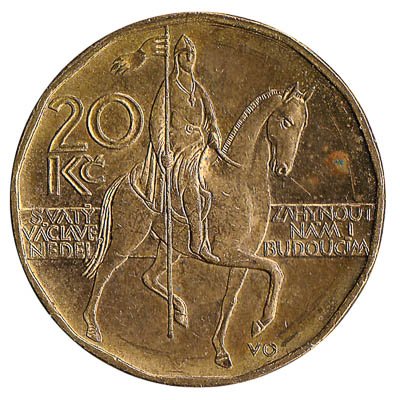
I like old money.
It was more art on it and more interesting than the new ones.
That sure is true in many cases. But these bills stick out even among older ones. I've never come across such intricate details. The old DM banknotes from the 80's were also quite pretty, but these Czechoslovakian ones have more colors.
That is some of the most colorful money I've ever seen. When I was young, I had a family member that took many international trips, and he always brought me coins and bills from his trips abroad. I used to love these gifts much more than any expensive toys.
I know, isn't money itself quite interesting though? Weird looking coins and bills from other places, or past eras! Thinking about it, the whole concept is rather strange: there are these objects that everyone has, passing to each other in exchange for stuff. And it has interesting designs on it, with known or unknown faces, diverse images, cryptic symbology, and lots of meaning everywhere. And people go crazy about having it, though most people completely ignore the appearance of their own money, simply because we're so used to dealing with it every day.